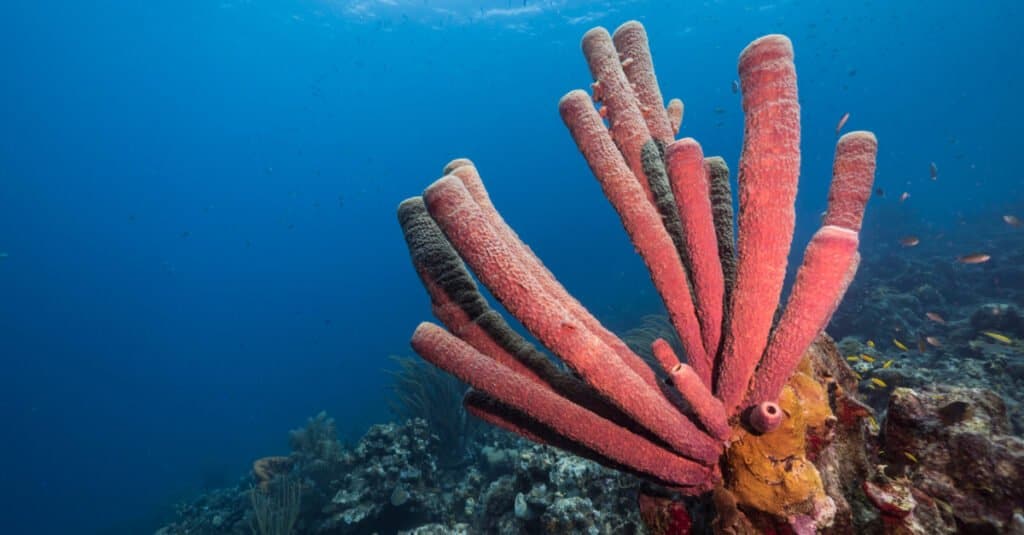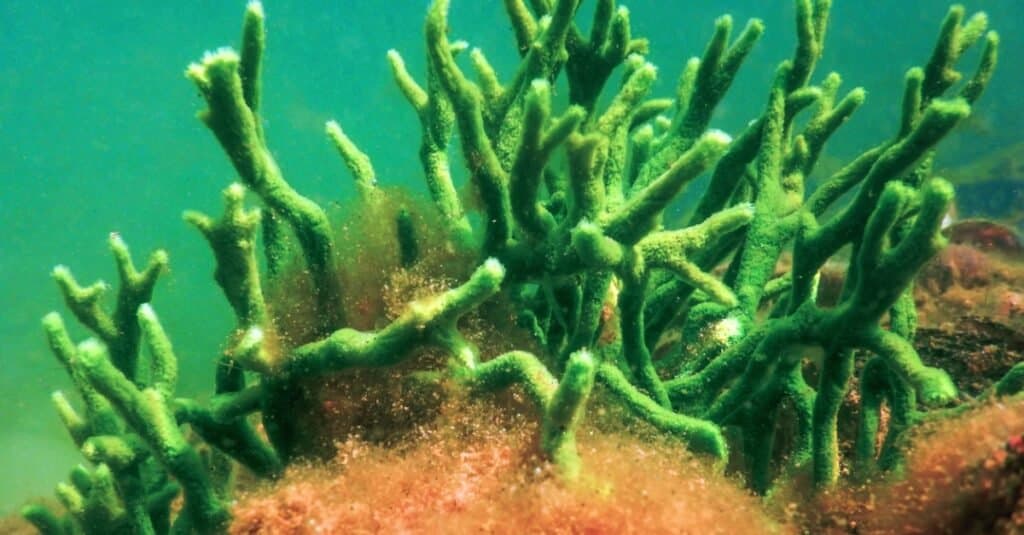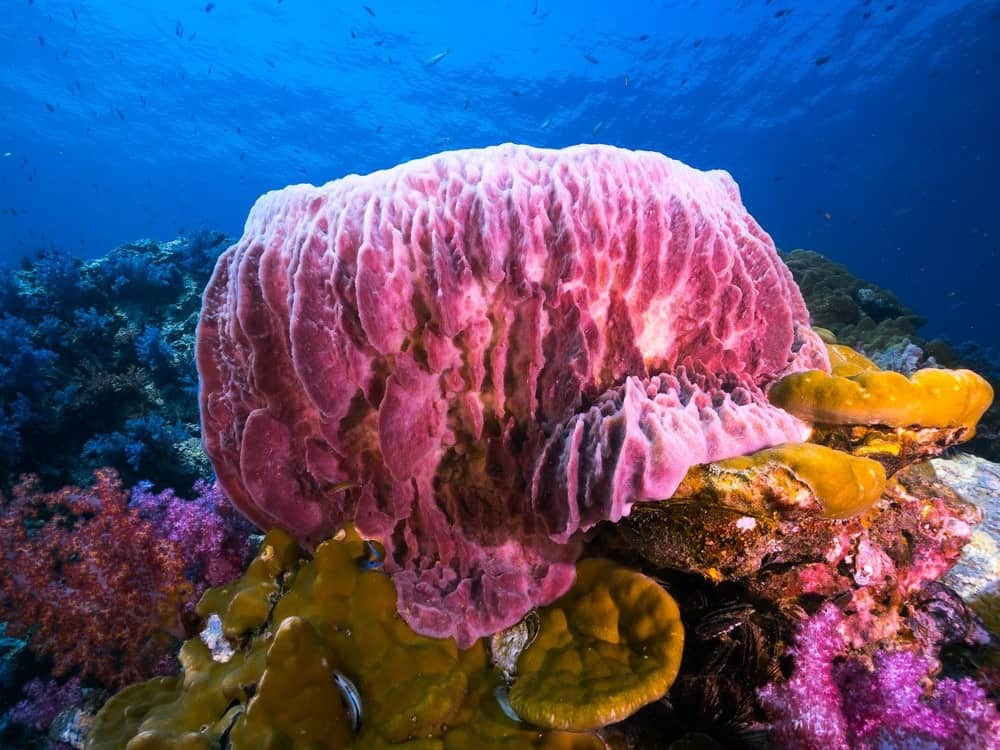Sponges, often known as “sea sponges,” are aquatic dwelling organisms that many people wouldn’t even recognize as an animal. Still, these fascinating organisms are the ancient “sister” ancestors of all animals and play an important role in evolutionary history. Although sponges don’t appear to do much, they are actually quite active in their role as filter feeders. Let’s look at that deceivingly active role and learn a bit about what sponges eat.
What do sponges eat?

Sponges are detrivores that eat microcellular life and dissolved organic materials.
©NaturePicsFilms/Shutterstock.com
Sponges eat plankton, viruses, bacteria, and other dissolved organic materials.
While most people may be familiar with the terms “omnivore” and “carnivore,” neither quite apply to the sponge. Sponges are filter feeders and passively allow water to flow through them, capturing any food that goes through. Since much of this food is bacteria and plankton, it’s single cellular in origin. Animals who filter microscopic life and debris as food are known as detrivores, as it’s more specific to their unique niche.
In their natural habitat, sponges suck up water and eat microscopic life. Most people are familiar with plankton, but sponges also eat viruses and bacteria that are suspended in the water. Many species of animal primarily feed on microscopic life in the ocean as it’s so plentiful. In fact, if you weighed all of the microscopic life in the oceans, it would account for 90% of the total biomass.
Aside from plankton, sponges eat bacteria, viruses, archaea, protists, and fungi. Although (most) single-celled organisms are impossible to see, sea sponges are able to digest them as they float through. It doesn’t look like much is happening, but a single teaspoon of seawater can be home to as many as 100 million viruses.
Carnivorous sponges
Sponges primarily eat microscopic organisms, but a few species of sponge are known to be carnivorous. As there are 8,550 documented species of sponge and only a few of them are carnivorous, it’s not typical of the group.
These carnivorous sponges live in very deep waters and use a variety of methods to capture their prey. From what scientists have observed, most carnivorous sponges eat small crustaceans and other small animals that can be captured passively. The primary method that these carnivorous sponges use to capture their prey involves sticky threads and hooks that loop around prey as it gets caught.
A second type of carnivorous sponge acts as a parasite to shells and coral structures. These parasitic sponges attach to their host and bore holes through them, draining them of nutrients. Eventually, the cavities and tubes collapse, killing the animal. These types of sponges are very dangerous for oyster and mussel farms for obvious reasons.
Freshwater sponges and endosymbionts

Freshwater sponge using symbiotic algae for nutrients.
©iStock.com/Allexxandar
Sponges are an incredibly diverse animal group, and as a result, their diets are varied. When it comes to freshwater sponges, many of them host “endosymbionts,” meaning they host other organisms within themselves for a specialized purpose. Within freshwater, many sponges host photosynthesizing algae within their own body structure, receiving nutrient benefits as the algae work.
In ecosystems where filter-feeding isn’t as viable, this relationship allows sponges to get 50-80% of their energy needs passively. Living in these specialized niches, they often develop “leafy” structures in order to better serve the photosynthesizing needs of algae.
A complete list of foods that sponges eat
Here is a complete list of foods that sponges will typically eat:
- plankton
- phytoplankton
- viruses
- bacteria
- amoeba
- organic debris
- crustaceans
- algae
- photosythesized nutrients
Although this is a complete list of foods for sponges, an accurate diet will depend on the species of sponge in question.
How do sponges hunt for their food?

Most sponges use passive methods to eat, but some are carnivorous and others symbiotic.
©Bangtalay/Shutterstock.com
There are three main ways that sponges get their food, although you might only consider one to be proper “hunting”:
- Passive filter feeding
- Carniverous digestion
- Symbiotic relationships
Primary sponge digestion through filter feeding
By and away, the most common way sponges eat is through passive filter feeding. Sponges are elementary animals, and their biological structure reflects that. They don’t have distinct respiratory, digestive, or waste systems. Instead, they transfer food directly from the water into the cells via vesicles. The incoming food passes through two filters as a sponge sits in nutrient-rich water. The first is the archaeocytes, amoeba-like cells that are designed for food that is 0.5 μm (micrometers) to 50 μm (micrometers). For reference, spider web silk is between 2-3 μm. The second filter is for anything below .5 μm, and choanocytes eat these food particles.
Alternative sponge digestion through hunting and symbiosis
Carnivorous digestion is much less common, but a few species of sponge “hunt” their food, albeit in a very passive way. One species of sponge, for example, has been found in Mediterranean caves where the water is very still and poor for filter-feeding organisms. As a result, these sponges capture their food using fine threads that entangle their prey. After their small prey (no larger than 1mm) is stuck, the sponge wraps it in further threads, and digestion begins. Another species of carnivorous sponges use modified inflation systems to “balloon” their body structure and capture prey.
Another form of eating that sponges partake in is through symbiotic relationships. Where filter-feeding isn’t a viable option but sunlight is still present, many sponges will form symbiotic relationships with algae. These photosynthesizing algae grow in and around the sponge and use it as a structure. As the algae produce food for themselves from the sun, the sponge is able to capture some of those nutrients. In some cases, the sponges even grow silica that acts as a “fiber” to transfer light to hard-to-reach places inside its own structure. In these symbiotic relationships, algae can become one-third of the total mass of the sponge and contribute up to 80% of its nutrient needs.
The photo featured at the top of this post is © John A. Anderson/Shutterstock.com
Thank you for reading! Have some feedback for us? Contact the AZ Animals editorial team.






